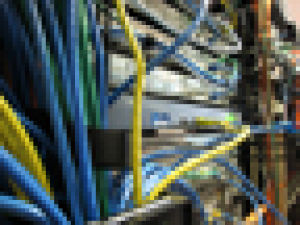University increases bandwidth by 50 percent
November 5, 2007
Slow Internet connection.
It’s a dilemma that everyone has encountered, usually at the most inconvenient of times. Because of low bandwidth, it’s also an issue that ISS Director Michael Gunter has been working on since mid-August.
Washburn has increased the bandwidth available to students by 50 percent, moving it from 20 megabits to 30 megabits. The addition is set to cost an extra $13,000 per year.
Gunter first realized the campus was in need of more bandwidth three days into the fall semester. His department received a wide range of complaints from everywhere on campus.
“It wasn’t a problem all the time, sometimes people would have a strong connection and other times they’d have little to none,” said Gunter. “We were basically right on the edge of not having enough bandwidth.”
With no significant change in enrollment numbers or online University services, he couldn’t understand how the demand for Internet bandwidth was up from the spring.
“We were really caught off guard by the demand, so we started tracking campus Internet usage to see if we could pinpoint where the elevated bandwidth usage was coming from,” said Gunter. “We thought perhaps the problem could be a specific increase in peer-to-peer downloading.”
But after finding no specific cause, Gunter decided to address the issue as an overall need for more Internet bandwidth. With the increased popularity in Web sites such as YouTube, Facebook and MySpace along with the overall growing necessities of the Internet, it’s no wonder Washburn has had to enlarge its bandwidth amount for the first time in two years.
Junior Jacie Norris, who utilizes the Internet for her homework, e-mail and Facebook, was optimistic when she learned of the bandwidth increase from one of her professors.
“I had noticed the greatest amount of lag while attempting to access the Internet in campus computer labs,” said Norris. “It took a significant amount of time to load basic Web site settings.”
Junior Alicia Phillips had the greatest struggle with the Internet connection while in her dorm. She frequently utilizes a number of search engines to complete research online. Although the bandwidth problem has been fixed, Phillips hasn’t noticed a significant change.
“The other afternoon I was on Facebook for a short while and it still was taking quite a while for pictures and pages to load,” said Phillips.
Gunter explained that the Washburn campus’s peak hours of online usage are between 8 a.m. and 5 p.m. During this time, Internet traffic from faculty and students is at its all-time high, which can contribute to slower Internet functioning.
Traffic shaping devices are designed to allocate the most bandwidth to “priority traffic” which includes activities such as e-mailing, Internet researching and online homework (i.e. WebCT discussions).
“Any leftover bandwidth goes toward peer-to-peer downloading and other traffic that isn’t as much of a mandatory priority,” said Gunter. “Students who are trying to download large files are better off doing so in the evening when the busy daytime traffic has slowed down.”
Gunter and his department tested the Internet speed with the new bandwidth for a week before notifying the entire campus of the change. Immediately he received positive feedback. While the entire bandwidth project took about six to seven weeks because of some misunderstandings with the bandwidth provider, Gunter is happy to be serving the technological needs of the Washburn community.
“In a way this is a good thing, because it means more people are using the Internet to collect resources,” said Gunter. “If students have research to do, it’s our job to purchase enough bandwidth to support that need.”



